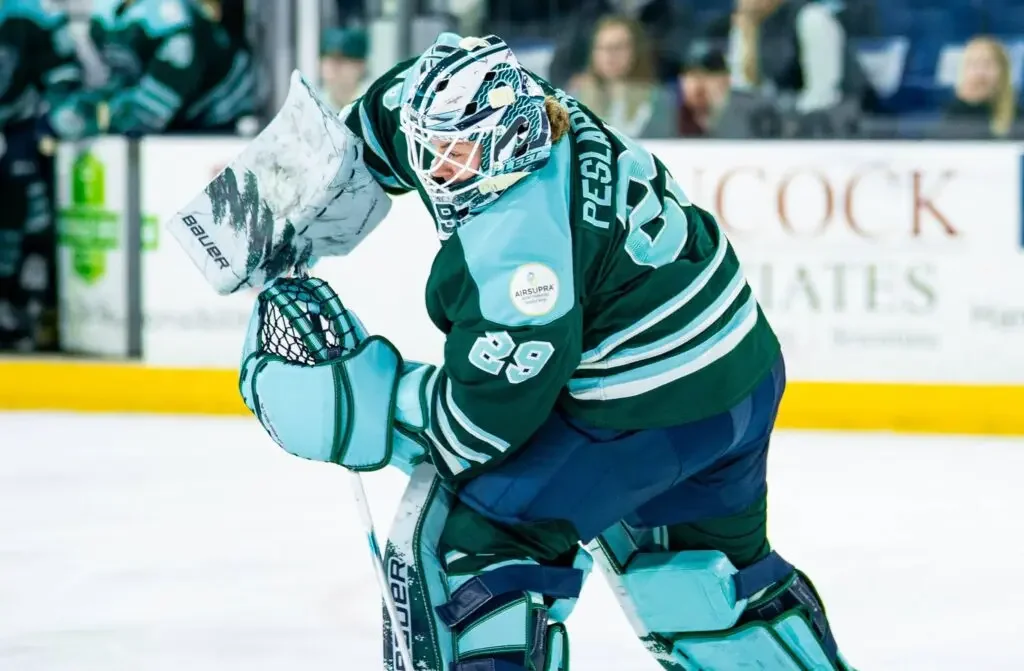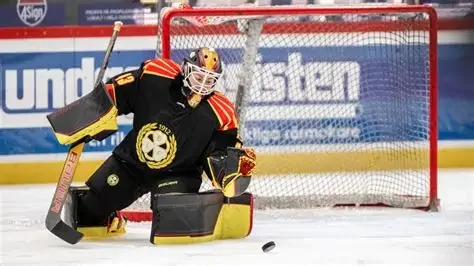Navigating Two Worlds: International Stars Return To Europe
Two years of the Professional Women’s Hockey League (PWHL) has brought together many of the world’s best players. Yet even as the league promises top-tier competition and unprecedented resources for women’s hockey, some European stars are opting to return home. Czech goaltender Klára Peslarová is one notable example. And after spending last season in the PWHL, she’s signed to play in Europe for the upcoming season. Her decision, made with the 2026 Olympic Games on the horizon, brings to light the difficult balancing act for international players torn between the PWHL and the familiarity and consistency of European leagues. We had the opportunity to chat with Cook Stark Management agent Eleni Demestihas (who represents both Peslarová, Noemi Neubauerová, and Finnish star Noora Tulus), and she was quick to mention it’s important not to generalize these moves.
We dive into Peslarová and Neubauerová’s journeys, their experiences in the PWHL, and the factors driving them back across the Atlantic in an Olympic year.
Klára Peslarová: From Boston Fleet to Brynäs IF
Klara Peslarová with the Boston Fleet during the ‘24-’25 season.
Peslarová joined the Boston Fleet as the third goaltender on the depth chart, a role she embraced with patience and determination. “She came in as a third goalie and had no problem waiting for the opportunity to shine,” Demestihas says, noting that Peslarová’s mental game remained strong despite limited starts. When her chance finally came late in the season, Peslarová made the most of it. She stopped all 29 shots she faced in her first PWHL start, earning a 3–0 shutout victory. In fact, in just 4 appearances she recorded 2 wins (1 by shutout) with a stellar 1.79 goals-against average and .937 save percentage for Boston. “I was waiting for this opportunity basically the whole season and when it came… I’m just grateful for it,” Peslarová said in an interview after that debut shutout, becoming the first European goaltender to notch such an accomplishment.
Despite her positive impact in Boston, Peslarová and her agent began discussing a possible return to Europe about halfway through the PWHL season. Several challenges unique to international players became apparent. The PWHL schedule, for instance, started much later than European leagues, while Sweden’s SDHL was already underway with preseason in August, the PWHL didn’t begin meaningful games until late November. For Peslarová, this meant months of waiting and then splitting the net once play began, which limited her game repetitions. Additionally, the league took breaks geared toward North American events like the USA-Canada Rivalry Series, breaks that “don’t help” European players who instead had to stay sharp for Euro Hockey Tour tournaments and other international commitments. Peslarová often had to leave her PWHL team for Czech national team camps or friendlies, facing long transatlantic flights and jumping into games “cold” without regular play. “Travel is much more significant for these players,” Demestihas points out. For a player trying to be in peak form by February (when the Olympic women’s hockey tournament will be held), constant jetlag and sporadic starts are serious concerns.
Peslarová with Brynäs in ‘23-’24
Demestihas emphasizes that playing in the PWHL was Peslarová’s goal for 2025-2026, and the goaltender had attracted interest from multiple PWHL teams (with some potential starting roles on the table) this offseason. But in weighing her priorities for this critical Olympic lead-up year, Peslarová ultimately decided that the logistical, physical, and emotional sacrifices required to stay in North America were not worth it. “The Olympic Games are in February, and every player wants to enter that tournament in mid-season form, playing at their absolute best,” Demestihas says. With that goal in mind, Peslarová chose the path that would maximize her playing time and comfort level. This summer she signed a contract to return to her former club, Brynäs IF in Sweden’s SDHL, on a two-year deal through 2026–27. The move reunites her with a team and league she knows well. Peslarová was a star in the SDHL before, posting a 935% save rate in the 2023–24 season with Brynäs. Brynäs management was thrilled to welcome her back, with GM Erika Grahm calling her “a goaltender of the highest class in Europe” whose return will fortify the team’s defense. For her part, Peslarová expressed relief and joy at coming back to a familiar environment. “It feels incredibly good to return to Brynäs after a year elsewhere. This team, this jersey, and this community mean so much to me. I’m so grateful my hockey journey brings me here again.”
Olympic Year Considerations: Form and Fitness First
It’s no coincidence that a player like Peslarová made this move with the 2026 Winter Olympics looming. For national team stalwarts like herself, the coming season is all about being in optimal game shape by February. The Czech women’s national team has risen to international prominence in recent years, historic bronze medals at the 2022 and 2023 IIHF World Championships, but the elusive still remains, an Olympic podium. Many of the team’s core veterans see Milan-Cortina 2026 as possibly their last, best chance to win an Olympic medal. That sense of urgency filters through the entire program. “Core players feel a lot of pressure on this team, perhaps more than many others, especially this year,” says Demestihas. For those who have been with the national program for years, helping it rise from Division I to a perennial top-4 in the world, this may be their final chance to clinch an Olympic medal and cement their legacy. Names like Aneta Tejralová, Kateřina Mrázová, and Denisa Křížová stand out as players who have carried this program from some of its earliest victories, now staring down perhaps one final chance at succeeding during the pinnacle of international sports.
Beyond just winning medals, the Czech leaders are driven to keep pushing the program forward so that the next generation can continue the progress. Consistency is key; and as others note, the question now is not if countries like Czechia can challenge the U.S. and Canada, but how they can maintain momentum EVERY year through strong development pathways.
In this context, any factor that could disrupt a player’s rhythm or fitness in the crucial months before the Olympics is weighed heavily. For European players in the PWHL, the stop-and-start schedule and extensive travel proved especially disruptive. Peslarová, for example, found herself leaving Boston for international duty multiple times, flying across 6–9 time zones, and then returning to find her PWHL team on a break or in a different phase of the season. The PWHL’s calendar simply didn’t align with the European and international hockey calendar. “Even in a world where a team gives them a starting job, they don’t start playing meaningful games until December,” Demestihas notes, highlighting the late start. And even once the PWHL season got rolling, a player might only appear in a fraction of games. “Most opportunities, you’re splitting the net, and you’re not playing every game,” she says of goaltenders’ situations. For Olympic-minded players, game frequency and consistency matter, they want to enter the Games having played as many high-level games as possible in the preceding months.
Travel is another significant wear-and-tear issue. The Euro Hockey Tour (a series of international tournaments throughout the season) is a key part of Team Czechia’s preparation and evaluation. But a Czech player based in, say, Minnesota or Boston must endure grueling travel to participate. “Traveling from places like Minnesota, Boston, now Seattle and Vancouver, isn’t conducive for a player that’s trying to come into the Olympic Games feeling their absolute best,” Demestihas explains. By contrast, a player based in Europe can hop around the continent more easily for camps and tournaments with far less jetlag. With Olympic gold or bronze on the line, these seemingly small edges, a few extra starts, a few less red-eye flights, can make a tangible difference.
PWHL’s Challenge: Keeping International Talent
Noemi Neubauerová winning the EWHL Cup with EV Zug prior to joining Toronto in the PWHL. She’ll return to Zug for ‘25-’26
The decision of an athlete Peslarová raise a broader theme: the PWHL, despite its status as the world’s strongest women’s league, faces challenges in retaining European talent in the short term. Peslarová is not alone. Noora Tulus and Emma Söderberg are examples of talents that have departed this offseason. Czech defender Dominika Lásková, for example, left Montreal to sign with SDE HF in Sweden. Noemi Neubauerová signed with EV Zug in Switzerland. These moves are a reality check that the PWHL must adapt if it wants to truly be a global destination for players. As Demestihas puts it bluntly, “Ultimately, this league is not yet designed for international players.” And we agree, but there is room for optimism.
To its credit, the PWHL has given women’s hockey professionals an unprecedented level of salary, amenities, and visibility. North American players, who previously might have had to hold full-time jobs while playing in lesser leagues, are now finally able to earn a living wage and focus on hockey. European players, too, appreciate these benefits, Peslarová and Neubauerová both acknowledged how incredible it was to play with and against the world’s best, and to have resources they never had before. But beyond salary and benefits, the “whole package” matters. Top European leagues like the SDHL (Sweden), SWHL (Switzerland), and Finland’s Aurora Liiga offer their own advantages: earlier start dates and longer regular seasons, more accommodating schedules for international play, and the comfort of playing closer to home (culturally and geographically). Demestihas suggests that fans and media need to recognize these factors when evaluating players’ choices. It’s easy to assume that every player would automatically stay in the PWHL given its prestige, but the reality is more nuanced.
As journalists and fans, we should resist the urge to frame these decisions as simply “PWHL vs Europe” in a judgmental way. Instead, the conversation should be about how the PWHL can evolve to better integrate international players. That might include scheduling changes, perhaps aligning breaks with IIHF tournaments or starting the season earlier, and providing support for travel or moving families overseas. Until such changes happen, some players will understandably choose the environment that best supports their short-term goals, even if that means leaving the bright spotlight of the PWHL for a while.
For Klára Peslarová, returning to Europe in an Olympic year is about taking control of her narrative. It’s about ensuring she is at her best when it matters most, even if that means stepping away from the sport’s newest marquee league (for now). Her story remind us that an athlete’s career is not one-size-fits-all, personal ambitions, national team pride, and practical considerations all intersect in complex ways. “Each athlete has to make the decision that aligns with their own interests,” Demestihas reiterates, and in these cases the scales tipped toward Europe. As the PWHL matures, it will hopefully find ways to accommodate the needs of its international stars so that staying in North America doesn’t feel like a competitive disadvantage. In the meantime, fans on both sides of the ocean can appreciate that players like Peslarová are doing what they believe is necessary to achieve greatness on the Olympic stage and beyond. After all, their potential future success in February will be a victory not just for Czechia, but for women’s hockey as a whole, and that’s something everyone can cheer for.


